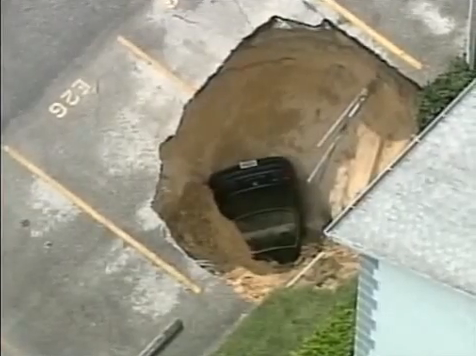But there's one unfortunate occurrence that happens here that many Floridians may not know much about: sinkholes.
Florida has the highest occurrence of sinkholes in the country according to the Florida Department of Environmental Protection.
Sinkholes occur when water moves through the layer of limestone, which is just below the land surface. As water moves through small holes in the limestone, the holes enlarge and the rock eventually dissolves.
The result? A collapse of ground sediments that become too heavy after lots of rain. The depression or hole that occurs is therefore coined a "sinkhole." In extreme cases, a sinkhole can grow 40 to 60 feet deep and wide in a matter of hours, according to the Florida Department of Environmental Protection's website.
Oviedo resident Tracy Squadrito learned all about sinkholes when the bottom of her kitchen sink fell through from outside water damage.
"The plumber said it must have been water damage underground. We thought it was a leaky pipe. When the city came to check it out, they thought it could be a sinkhole and sent an engineer to further take care of it," Squadrito said.
"As we were checking into all this, everyone out here said this is a big problem in the area, especially this time of year."
Although Oviedo gets a lot of calls from people who think their house is on a sinkhole, it's typically not the case, says David Waller, the operations manager for the Oviedo Public Works department.
"A lot of settling around houses is from vegetative material decomposing. This region is not really prone to them, but we will always go out and inspect them," he said.
Waller explained that, if upon inspection it looks like there could be sinkhole activity, a geotechnical engineer will come out to further examine the problem. From there, it is the property owner's responsibility to go through their homeowners' insurance to take care of it.
Florida Law requires insurance companies to provide coverage for damage caused by sinkholes. Your insurance company will make an initial inspection of the property to determine if the damage is consistent with sinkhole activity. At that point, insurance coverage should obtain and pay for a qualified expert to investigate the damage and to issue a written certification as to whether the damage was caused by a sinkhole.
Over the years, much work has been done to re-write guidelines for sinkhole coverage due to faulty claims or adjusters thinking there's a sinkhole there when there isn't.
Angie Martinez, operations director for Florida Chartered and Silver Insurance groups, said that 40 percent of claims are not sinkholes.
"Sinkholes are tricky," she said. "The inspector will come out and call it a sinkhole, but it's not. In Florida we have a lot of settling, crackling and what not, and inspectors attribute it to a sinkhole. But you may not find out it's a sinkhole without digging underneath your house, which is costly."
During the 2011 Florida Legislative session, one of the most debated issues revolved around sinkhole insurance and, more specifically, the definition of structural damage.
The new law requires carriers to offer sinkhole coverage, albeit with a much improved definition of structural damage, a two-year claims filing deadline, which was reduced from five years, and the right to inspect for sinkholes prior to insuring the risk.
Here are some key clues that your home could be on a sinkhole:
- Circular patches of wilting vegetation.
- Cracking in your walls, floor, pavement or pool deck.
- Sagging or slanting fence posts, trees, etc.
- Fresh exposures on fence posts, trees, etc.
- Small pond formation after rain where water has not collected before.
- Doors or windows no longer closing properly.
- Newly-depressed area or a small hole in yard.
- Sediment in your water.
- Neighbors who have had a sinkhole.




Reader Comments
to our Newsletter